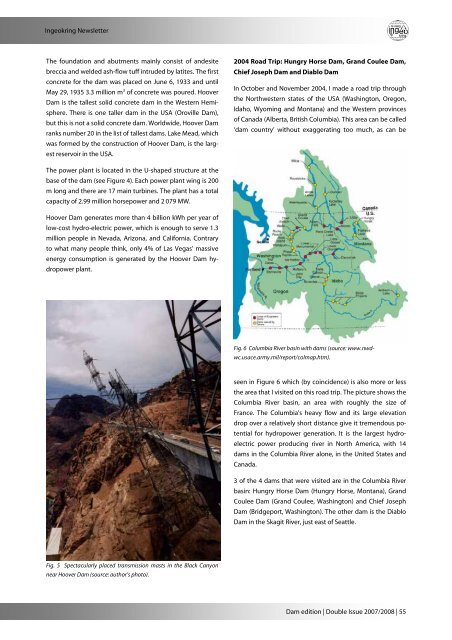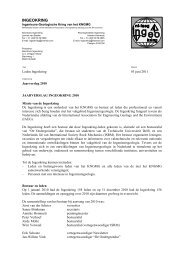News letter Dam edition
News letter Dam edition
News letter Dam edition
- No tags were found...
Create successful ePaper yourself
Turn your PDF publications into a flip-book with our unique Google optimized e-Paper software.
Ingeokring <strong>News</strong><strong>letter</strong><br />
The foundation and abutments mainly consist of andesite<br />
breccia and welded ash-flow tuff intruded by latites. The first<br />
concrete for the dam was placed on June 6, 1933 and until<br />
May 29, 1935 3.3 million m 3 of concrete was poured. Hoover<br />
<strong>Dam</strong> is the tallest solid concrete dam in the Western Hemisphere.<br />
There is one taller dam in the USA (Oroville <strong>Dam</strong>),<br />
but this is not a solid concrete dam. Worldwide, Hoover <strong>Dam</strong><br />
ranks number 20 in the list of tallest dams. Lake Mead, which<br />
was formed by the construction of Hoover <strong>Dam</strong>, is the largest<br />
reservoir in the USA.<br />
2004 Road Trip: Hungry Horse <strong>Dam</strong>, Grand Coulee <strong>Dam</strong>,<br />
Chief Joseph <strong>Dam</strong> and Diablo <strong>Dam</strong><br />
In October and November 2004, I made a road trip through<br />
the Northwestern states of the USA (Washington, Oregon,<br />
Idaho, Wyoming and Montana) and the Western provinces<br />
of Canada (Alberta, British Columbia). This area can be called<br />
‘dam country’ without exaggerating too much, as can be<br />
The power plant is located in the U-shaped structure at the<br />
base of the dam (see Figure 4). Each power plant wing is 200<br />
m long and there are 17 main turbines. The plant has a total<br />
capacity of 2.99 million horsepower and 2 079 MW.<br />
Hoover <strong>Dam</strong> generates more than 4 billion kWh per year of<br />
low-cost hydro-electric power, which is enough to serve 1.3<br />
million people in Nevada, Arizona, and California. Contrary<br />
to what many people think, only 4% of Las Vegas’ massive<br />
energy consumption is generated by the Hoover <strong>Dam</strong> hydropower<br />
plant.<br />
Fig. 6 Columbia River basin with dams (source: www.nwdwc.usace.army.mil/report/colmap.htm).<br />
seen in Figure 6 which (by coincidence) is also more or less<br />
the area that I visited on this road trip. The picture shows the<br />
Columbia River basin, an area with roughly the size of<br />
France. The Columbia's heavy flow and its large elevation<br />
drop over a relatively short distance give it tremendous potential<br />
for hydropower generation. It is the largest hydroelectric<br />
power producing river in North America, with 14<br />
dams in the Columbia River alone, in the United States and<br />
Canada.<br />
3 of the 4 dams that were visited are in the Columbia River<br />
basin: Hungry Horse <strong>Dam</strong> (Hungry Horse, Montana), Grand<br />
Coulee <strong>Dam</strong> (Grand Coulee, Washington) and Chief Joseph<br />
<strong>Dam</strong> (Bridgeport, Washington). The other dam is the Diablo<br />
<strong>Dam</strong> in the Skagit River, just east of Seattle.<br />
Fig. 5 Spectacularly placed transmission masts in the Black Canyon<br />
near Hoover <strong>Dam</strong> (source: author’s photo).<br />
<strong>Dam</strong> <strong>edition</strong> | Double Issue 2007/2008 | 55




